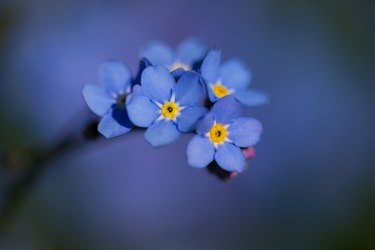
Dainty, delicate forget-me-nots come in a wide variety of types and colors, including the common forget-me-not (Myosotis sylvatica, USDA zones 3-8) and the true forget-me-not (Myosotis scorpioides, zones 5-9). All types grow well in pots, where their sometimes aggressive growth can be more easily controlled. Potted forget-me-not flowers need relatively little care once established, but they must be grown under the right conditions to encourage flowering.
Climate and Hardiness
Video of the Day
Hardiness varies according to species and cultivars. The common forget-me-not is a perennial in USDA zones 3 to 8, with cultivars that include Victoria Blue (Myosotis sylvatica 'Victoria Blue'). True forget-me-nots are slightly less cold-tolerant and perform best in USDA zones 5 to 9. If you're growing forget-me-nots in containers indoors, your USDA zone doesn't matter as much, as the flowers will grow in a controlled environment. Overwintering the plants indoors means you might be able to push the normal USDA zones for the plants if you choose to put them outside in the summer.
Video of the Day
Growing Forget-Me-Nots in Pots
Regardless of species or cultivar, all forget-me-nots share the need for similar growing conditions. Sun exposure is a key factor to growing forget-me-nots, especially when cultivating them in pots. Midday shade suffices in cooler climates, although part shade all day is best in warmer climates with hot summers. Forget-me-nots handle full sun better when grown in very moist or wet soil.
Choosing the right pot and soil also plays a major role in growing potted forget-me-nots. Plastic pots are lighter and lose moisture less quickly than ceramic or clay pots, which makes them a good choice for moisture-loving plants such as forget-me-nots. Both common and true forget-me-nots reach a similar mature height of 6 to 12 inches, although the former spreads 6 to 8 inches while the latter spreads 8 to 12 inches. A 12- to 18-inch pot with multiple drainage holes around the base will provide the right amount of space and the correct drainage for a single forget-me-not plant. Or plant two plants in a 24- to 36-inch pot.
Forget-me-nots need moderate to poor soil fertility to perform well. Mix 2 parts potting soil, 1 part compost and 1 part coarse sand or perlite to improve the drainage and nutrient content of the soil. Fill to within 2 inches of the top of the pot, and don't tamp down soil too much. Rich soil encourages legginess and poor blooming, so avoid potting mixes with added fertilizer.
Basic Care
Forget-me-nots are relatively low-maintenance plants, although potted specimens need a little extra attention to look their best. Potted forget-me-nots dry out faster than those grown in the garden. Provide 1 inch of water weekly during dry weather. Water until excess liquid trickles from the bottom of the pot, then wait until the soil surface dries out before watering again. True forget-me-nots are water-loving plants. Don't let their soil dry out completely or they may go dormant.
Forget-me-nots benefit from a light application of fertilizer each spring. When growing forget-me-nots in pots, spread slow-release, granular 10-10-10 fertilizer onto moist soil at the rate indicated on the label. Apply the fertilizer to moist soil to avoid root burn.
Overwintering Potted Forget-Me-Not Flowers
Forget-me-nots overwinter well in containers, which helps widen their growing range to include colder climates. The most effective and least labor-intensive way of overwintering forget-me-nots is to move their pots into an unshaded cold frame with southerly exposure. True forget-me-nots may need to be moved indoors to a heated room with unshaded, south-facing windows during the winter because of their limited cold tolerance.
During the winter, water the plants occasionally. Water them deeply but infrequently, allowing the soil to dry out almost completely before watering again. Do not let plants sit on soggy soil during cold weather; it will rot their roots. Rotating the pot by 90 degrees every week or so will expose the entire plant to light, which will help it grow more evenly come spring.
In spring, move the pot to a sheltered location outdoors after all frost danger has passed. Keep it there for a week or two to re-acclimatize it to outdoor conditions, then move it to its original growing location. Resume regular watering and fertilizing once it shows signs of growth.
Special Care Tips
Forget-me-nots may spread aggressively if preventative measures aren't taken. Growing in pots will limit their spread via rhizomes, but most varieties still produce an abundance of highly viable seed. Removing the faded flowers, or deadheading, will help eliminate unwanted seedlings and will improve the look of the plants, which often take on a scraggly, unattractive appearance after blooming. Before deadheading, wipe pruning shear blades with alcohol. Rinse them well and wipe dry before use.
Growing forget-me-nots in pots instead of in the ground gives you more flexibility in where you grow them. You can easily overwinter the flowers indoors and control growth, so you can enjoy the flowers with easier maintenance.